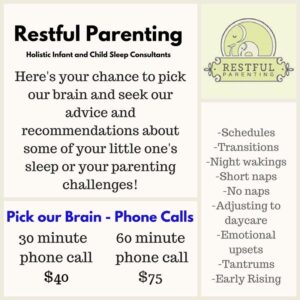Sleep Transitions: When and How to Drop From 2 Naps to 1
Share this:

Does your child seem ready to drop their morning nap? As sleep consultants, we often get asked about how to know when a child is ready to transition from 2 naps to 1 and how to go about making the transition to drop from 2 naps to 1 smoothly, so we thought we would share some tips with you.
How do you know your child is ready to drop a nap?
Ideally a child should be between 14-18 months old to drop that morning nap. If your child is younger than 14 months and you need them to drop that morning nap for daycare or whatever reason, it can be done earlier if you really need to, however it may be more of a challenge as a younger child really does crave that morning nap. There will be less sleep interruptions if you can wait and choose a more optimal time to make the transition.
Check out our video where we discuss our tips on dropping from 2 naps to 1.
Here is a summary of the tips we shared in the video:
The signs they are ready to transition from 2 naps to 1:
- Taking way too long to settle for the first nap of the day
- Don’t settle at all for that morning nap. Refusing to sleep for that first nap of the day consistently for several days at least- don’t jump the gun on this one just because they don’t settle for a day or two
- Have a morning nap and then refusing to sleep for the afternoon nap
- Or taking way too long to fall asleep for the afternoon nap
First step to make the transition to drop from 2 naps to 1:
If the afternoon nap is being affected, start by cutting the morning nap by 15-20 min increments every few days before cutting it out entirely. Sometimes this short nap is enough to get them through the morning without ruining the afternoon nap!
The afternoon nap is the most important nap of the day! Although at 6 months old, we start to focus on the ‘schedule’ as opposed to ‘wake windows’ for optimal sleep, that afternoon wake window is still very important right up until they drop naps entirely. If there is too long of a period of time from the end of nap time to bedtime you may have one cranky child on your hands or find bedtime needing to happen before you even get dinner made!
The afternoon nap should be right in the middle of the day: 12:30/1pm is the ideal time for the afternoon nap but if your child is too tired to make it to 12:30pm, you can start earlier for the first while- nap time may be 11:30am-11:45am, but only short term as you don’t want them waking at 1pm and not being able to make it to bedtime-we call this the 11 o’clock nap trap! Work your way to the 12:30/1pm by extending the nap time in short increments of about 15 minutes each day.
Avoid cat naps!
Your child may still be very tired mid-morning, so try to avoid long car rides or stroller rides where they will fall asleep. If you can’t avoid them, try these tips to keep them awake:
- have a bag of toys in the front seat and give them toys every few minutes to keep them awake and stimulated so they don’t fall asleep,
- sing loudly, play music loudly, or call their name,
- if you can, pullover to stop the car to take a moment to re-stimulate them,
- if out for a walk with the stroller, let them walk or show them around to re-stimulate them to keep them awake.
The side effects of dropping naps
While you are making the transition from 2 naps to 1, it is quite common that sleep disturbances may begin at night and more likely may cause early rising (read about early rising here).
The length of naps may also be affected: ideally, they will combine their nap lengths (ie: if they slept 1.5 hour in the morning and 1.5 hours in the afternoon they will nap for 3 hours now) but it can take some time before the afternoon naps get longer: stay consistent, keep the room dark, have minimal stimulation, don’t encourage the short naps. Two hour+ naps are ideal.
Consistency will be your key to success!
We hope these tips help you decide whether or not your child is ready to make the transition from 2 naps to one and help you get through the transition.

Our one on one , Pick our Brain calls are available if you have more questions about this or need help getting through these transitions! Pick our Brain Calls are also great for questions about schedules, other nap transitions, starting daycare, etc. Contact us here to Pick our Brain!
Meet Jennifer Taun
MSW, RSW – Partnering with Restful Parenting

We are excited to introduce Jennifer Taun, MSW, RSW, as a valued partner with Restful Parenting. Jennifer will be providing consultation and supervision support for our team, working closely with Elisa and Pam to ensure our clients receive comprehensive, effective, and compassionate care.



